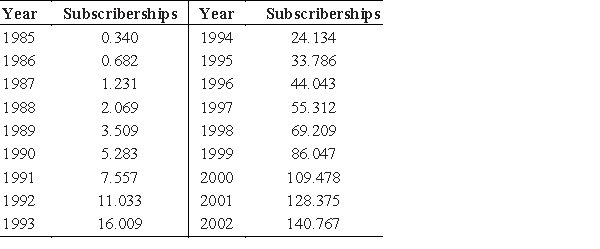The following table shows the numbers of U.S. cellular subscriberships (in millions) from 1985 to 2002.  Source: The CTIA Semi-Annual Wireless Industry Survey
Source: The CTIA Semi-Annual Wireless Industry Survey
Assume that the number of U.S. cellular subscriberships, in millions, can be modeled by the function  , where t is the number of years past 1980. Find the function that models the instantaneous rate of change of the U.S. cellular subscriberships.
, where t is the number of years past 1980. Find the function that models the instantaneous rate of change of the U.S. cellular subscriberships.
A) 
B) 
C) 
D) 
E) 
Correct Answer:
Verified
Q225: Total revenue is in dollars and x
Q226: The graph of a company's total cost
Q227: Total revenue is in dollars and x
Q228: In this problem, cost, revenue, and profit
Q229: In this problem, cost, revenue, and profit
Q231: The following table shows the numbers of
Q232: If the cost function for a commodity
Q233: Total revenue is in dollars and x
Q234: Total revenue is in dollars and x
Q235: In this problem, cost, revenue, and profit
Unlock this Answer For Free Now!
View this answer and more for free by performing one of the following actions

Scan the QR code to install the App and get 2 free unlocks

Unlock quizzes for free by uploading documents